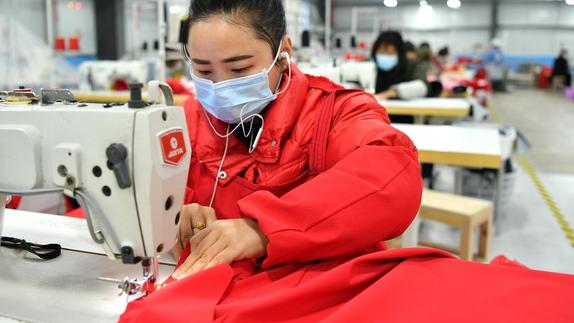 Workers wearing face masks work at a garment factory in Enshi, Hubei province, March 16, 2020. (PHOTO / XINHUA)
Workers wearing face masks work at a garment factory in Enshi, Hubei province, March 16, 2020. (PHOTO / XINHUA)
BEIJING - China's producer prices rose at a faster pace in May, bolstered by steady recovery in domestic demand, official data showed Wednesday.
China's producer price index (PPI), which measures costs for goods at the factory gate, went up 9 percent year on year last month, accelerated from the 6.8-percent growth in April, according to the National Bureau of Statistics (NBS).
On a monthly basis, the PPI gained 1.6 percent, quickening by 0.7 percentage points from April, data from the NBS showed
The carryover effect contributed 3 percentage points to the PPI growth, while new price increases contributed 6 percentage points.
ALSO READ: China's factory-gate prices at highest level since July 2018
On a monthly basis, the PPI gained 1.6 percent, quickening by 0.7 percentage points from April, data from the NBS showed.
China's factory prices returned to positive growth in January, the first time since the novel coronavirus outbreak, representing its fifth consecutive month of positive gains.
In May, the prices of international crude oil, iron ore and non-ferrous metals rose further, driving up the prices of industrial products in China, said Dong Lijuan, an NBS senior statistician.
The PPI for the country's domestic oil and natural gas extraction sector grew 1.7 percent month on month in May, up by 1.3 percentage points from the growth in April.
Furthermore, as factories started to add reserves of steam coal to meet the summer power peak, the demand for such products surged, pushing up the PPI of the coal mining and washing industries to jump 10.6 percent month on month during the period.
In the first five months, the PPI growth averaged at 4.4 percent year on year, according to the NBS.
CPI up 1.3%
The PPI data came along with the release of the consumer price index, a main gauge of inflation, which gained 1.3 percent year on year in May.
The growth was faster than the 0.9-percent year-on-year growth in April, which is mainly due to the stronger carry-over effect of last year's price changes, said Dong Lijuan, a senior statistician with the NBS.
The carryover effect contributed 0.7 percentage points to the CPI growth, while new price increases contributed 0.6 percentage points, the NBS data showed.
READ MORE: China's factory-gate prices rise in Jan as demand improves
Food prices climbed 0.3 percent year on year in May, reversing the 0.7-percent decline in April, pushing up the consumer inflation by 0.05 percentage points, according to the data.
On a monthly basis, the CPI declined 0.2 percent, with food prices down 1.7 percent, narrowing the decline by 0.7 percentage points from April, NBS data showed.



